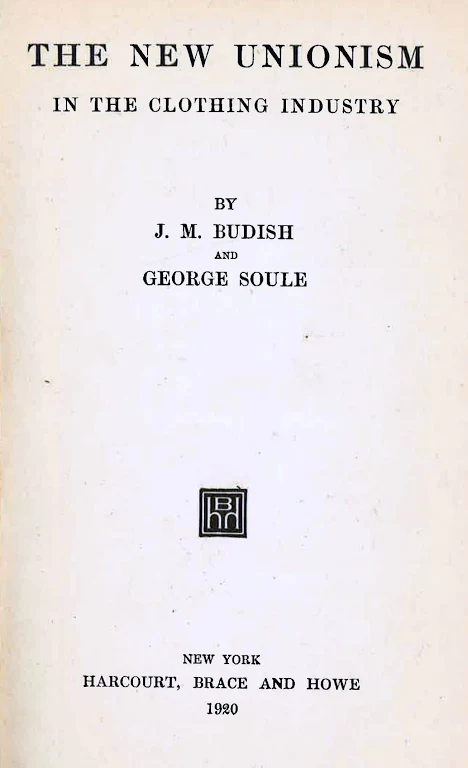
First Published: 1920.
Transcription, Editing and Markup: Paul Saba
Copyright: This work is in the Public Domain under the Creative Commons Common Deed. You can freely copy, distribute and display this work; as well as make derivative and commercial works. Please credit the Marxist Internet Archive as your source, include the url to this work, and note any of the transcribers, editors & proofreaders above.
Success of the Clothing Unions
British New Unionism
Industrial Workers of the World
Hoxie’s Classification of Unions
Tendencies Toward New Unionism in U.S.
Characteristics of the Clothing Unions
CHAPTER II. THE CLOTHING INDUSTRY
Magnitude of the Industry
Divisions of the Industry
History of Men’s Clothing Trades
History of Women’s Clothing Trades
Seasonal Character
Fluidity of Labor
Fashions
Power Installation
Size and Number of Establishments
Contractors and Sub-Manufacturers
Difficulty of Controlling Industry
Variations in Efficiency
Difficulty of Mobilizing Labor
Number of Women Employed
The Function of the Unions
CHAPTER III. THE HUMAN ELEMENT
Assumed Radicalism of the Immigrant
Personnel of the Clothing Industry
Situation of East-European Jews
Culture of the Jews
Persecution of Jews in Russia
Anti-Jewish Movement in Rumania and Austria-Hungary
What the Jews Sought in America
Proportion of Socialists Among Jewish Immigrants
Development of Socialism Among Jews in the U.S.
Italian Immigration
Influence of Race and Leadership
CHAPTER IV. THE UNIONS–THEIR BEGINNINGS AND GROWTH
The Unions
Their History to 1900
The United Garment Workers
The United Cloth Hat and Cap Makers of North America
The International Ladies’ Garment Workers Union
Backwardness of the U.G.W.
The Nashville Conventions
The Amalgamated Clothing Workers of America
A Needle Trades Federation
The International Fur Workers’ Union
The Journeyman Tailors’ Union
The United Neckwear Makers
The Suspender Makers Union
Present Strength of the Unions
The Workers’ State of Mind
A Typical Tenement
A Contractor’s Shop
Specific Grievances
New York Cloak Strike of 1910
Signing of the Protocol
Chicago Men’s Clothing Strike of 1910
More Recent Achievements
CHAPTER VI. COLLECTIVE AGREEMENTS
Community of Interest Between Employer and Employee
Conflict of Interest
Collective Agreement
Operation of Protocol Machinery
Friction Under the Protocol
Causes of Complaint
The Fundamental Conflict
Abrogation of Protocol
Cloakmakers’ Agreement of 1916
Agreements of 1919 in Women’s Industry
Joint Board of Sanitary Control
Hart, Schaffner and Marx Agreements
Impartial Machinery in New York Men’s Industry
Industrial Council in Men’s Industry
Other Agreements
CHAPTER VII. PHILOSOPHY, STRUCTURE, AND STRATEGY
Power of the Needle-Trades Unions
Function of Ideas
Origins of Old Unionism
Origins of Clothing Unions
First Expressions of their Philosophy
Leadership
Structure of the Clothing Unions
Strategy of the Clothing Unions
Interest in the Unions’ Educational Work
Educational Function of Unions Themselves
Early Labor Education
New Conception of Education
International Ladies’ Garment Workers’ Activities
United Labor Education Committee
New Unionist’s Attitude Towards Education
CHAPTER IX. LABOR PRESS AND COOPERATIVES
Growing Power of the Press
Bias of the Capitalist Press
Union Journals in English
Early Jewish Workers’ Press
The Forward
Other Journals
Clothing Union Publications
Cooperative Enterprises
A Cooperative Bank
Inter-Relation of Textiles and Clothing
The Textile Industry
The Labor Force in Textiles
The Older Unions
The Lawrence Strike of 1919
The Amalgamated Textile Workers
Competition Between New and Old Unions
Amalgamation with Clothing Workers
Speculation About the Future
What Remains to be Achieved
Wages and Productivity
Seasonal Unemployment
Workers’ Control of the Industry
Cooperative Production
Revolutionary General Strike
Socialization by Political and Economic Action
Future Policy of the Workers
Interests of the Public
Comparative Dangers from Conservative and Radical Unions
Necessity of Experiment and Change